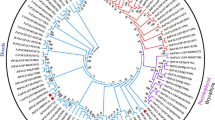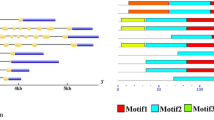Abstract
Phenylalanine ammonia-lyase (PAL) catalyzes the initial step of phenylpropanoid biosynthesis in plants. Five PAL genes (PtrPAL1 to 5) have been identified in Populus trichocarpa. These genes are classified into two subgroups according to their transcript sequence similarity and tissue specificity. However, the regulation of these genes and their protein functions are not well understood. In this study, enzymatic properties of each PtrPALs were characterized based on their recombinant proteins expressed in E.coli. Subcellular localizations of each PtrPALs in stem wood forming tissue were investigated and individual PtrPAL protein abundances in cytosol and membrane protein fractions were measured using protein cleavage-isotope dilution mass spectrometry (PC-IDMS). Protein/mRNA ratios of PtrPALs were further verified using RNA-Seq and gel-enhanced liquid chromatography mass spectrometry (GeLC-MS). All PtrPALs have similar catalytic properties for the deamination of l-phenylalanine, their major substrate. All PtrPALs have similar subcellular locations in stem wood forming tissue, with major amount in the cytosol (93–96 %) and less in the membrane (4–7 %). However, the protein/mRNA ratios of subgroup A (PtrPAL2, 4 and 5) are about five times that of subgroup B (PtrPAL1 and 3) in stem wood forming tissue, while all PtrPALs have similar transcript abundances. These results indicate a greater functional significance of subgroup A PtrPALs for stem wood formation, and highlight the role of gene post-transcriptional regulation.



Similar content being viewed by others
References
Achnine L, Blancaflor EB, Rasmussen S, Dixon RA (2004) Colocalization of l-phenylalanine ammonia-lyase and cinnamate 4-hydroxylase for metabolic channeling in phenylpropanoid biosynthesis. Plant Cell 16:3098–3109
Ahmed H (2005) Principles and reactions of protein extraction. CRC Press, Boca Raton
Appert C, Logemann E, Hahlbrock K, Schmid J, Amrhein N (1994) Structural and catalytic properties of the four phenylalanine ammonia-lyase isoenzymes from parsley (Petroselinum crispum Nym.). Eur J Biochem 225:491–499
Araujo PR, Yoon K, Ko D, Smith AD, Qiao M, Suresh U, Burns SC, Penalva LO (2012) Before It gets started: regulating translation at the 5′UTR. Comp Funct Genomics 2012:475731
Bagal UR, Leebens-Mack JH, Lorenz WW, Dean JF (2012) The phenylalanine ammonia lyase (PAL) gene family shows a gymnosperm-specific lineage. BMC Genomics 13(Suppl 3):S1
Bassard JE, Mutterer J, Duval F, Werck-Reichhart D (2012) A novel method for monitoring the localization of cytochromes P450 and other endoplasmic reticulum membrane associated proteins: a tool for investigating the formation of metabolons. FEBS J 279:1576–1583
Chen HC, Li Q, Shuford C, Liu J, Muddiman D, Sederoff R, Chiang VL (2011) Membrane protein complexes catalyze both 4- and 3-hydroxylation of cinnamic acid derivatives in monolignol biosynthesis. PNAS 108:21253–21258
Chiang VL (2002) From rags to riches. Nat Biotechnol 20:557–558
Cochrane FC, Davin LB, Lewis NG (2004) The Arabidopsis phenylalanine ammonia lyase gene family: kinetic characterization of the four PAL isoforms. Phytochemistry 65:1557–1564
Czichi U, Kindl H (1975) Formation of p-coumaric acid and o-coumaric acid from l-phenylalanine by microsomal membrane fractions from potato: evidence of membrane-bound enzyme complexes. Planta 125:115–125
Gao L, Fang Z, Zhang K, Zhi D, Cui X (2011) Length bias correction for RNA-seq. data in gene set analyses. Bioinformatics 27:662–669
Hrazdina G, Wagner G (1985) Metabolic pathways as enzyme complexes: evidence for the synthesis of phenylpropanoids and flavonoids on membrane-associated enzyme complexes. Arch Biochem Biophys 237:88–100
Jorrin J, Dixon R (1990) Stress responses in alfalfa (Medicago sativa L.) II. Purification, characterization, and induction of phenylalanine ammonia-lyase Isoforms from elicitor-treated cell suspension cultures. Plant Physiol 92:447–455
Kao YY, Harding SA, Tsai CJ (2002) Differential expression of two distinct phenylalanine ammonia-lyase genes in condensed tannin-accumulating and lignifying cells of quaking aspen. Plant Physiol 130:796–807
Lepelley M, Mahesh V, McCarthy J, Rigoreau M, Crouzillat D, Chabrillange N, de Kochko A, Campa C (2012) Characterization, high-resolution mapping and differential expression of three homologous PAL genes in Coffea canephora Pierre (Rubiaceae). Planta 236:313–326
Li Q, Lin Y, Sun YH, Song J, Chen H, Zhang X, Sederoff R, Chiang VL (2012) Splice variant of the SND1 transcription factor is a dominant negative of SND1 members and their regulation in Populus trichocarpa. PNAS 109:14699–14704
Liang XW, Dron M, Cramer CL, Dixon RA, Lamb CJ (1989) Differential regulation of phenylalanine ammonia-lyase genes during plant development and by environmental cues. J Biol Chem 264:14486–14492
Liu H, Sadygov RG, Yates JR 3rd (2004) A model for random sampling and estimation of relative protein abundance in shotgun proteomics. Anal Chem 76:4193–4201
Liu J, Shi R, Li Q, Sederoff R, Chiang VL (2012) A standard reaction condition and a single HPLC separation system are sufficient for estimation of monolignol biosynthetic pathway enzyme activities. Planta 236:879–885
MacDonald MJ, D’Cunha GB (2007) A modern view of phenylalanine ammonia lyase. Biochem Cell Biol 85:273–282
Maier T, Schmidt A, Güell M, Kühner S, Gavin AC, Aebersold R, Serrano L (2011) Quantification of mRNA and protein and integration with protein turnover in a bacterium. Mol Syst Biol 7:511
Malys N, McCarthy JE (2011) Translation initiation: variations in the mechanism can be anticipated. Cell Mol Life Sci 68:991–1003
Mortazavi A, Williams BA, McCue K et al (2008) Mapping and quantifying mammalian transcriptomes by RNASeq. Nat Methods 5:621–628
Mosley AL, Sardiu ME, Pattenden SG, Workman JL, Florens L, Washburn MP (2011) Highly reproducible label free quantitative proteomic analysis of RNA polymerase complexes. Mol Cell Proteomics 10: M110.000687. doi:10.1074/mcp.M110.000687
Motameny S, Wolters S, Nurnberg R, Schumacher B (2010) Next generation sequencing of miRNAs—strategies, resources and methods. Genes 1:70–84
Nie L, Wu G, Zhang W (2006) Correlation between mRNA and protein abundance in Desulfovibrio vulgaris: a multiple regression to identify of variations. Biochem Biophys Res Commun 339:603–610
Olsen KM, Lea US, Slimestad R, Verheul M, Lillo C (2008) Differential expression of four Arabidopsis PAL genes; PAL1 and PAL2 have functional specialization in abiotic environmental-triggered flavonoid synthesis. J Plant Physiol 165:1491–1499
Pietarinen S, Willför S, Vikström F, Holmbom B (2006) Aspen knots, a rich source of flavonoids. J Wood Chem Technol 26:245–258
Rasmussen S, Dixon RA (1999) Transgene-mediated and elicitor-induced perturbation of metabolic channeling at the entry point into the phenylpropanoid pathway. Plant Cell 11:1537–1551
Reichert AI, He XZ, Dixon RA (2009) Phenylalanine ammonia-lyase (PAL) from tobacco (Nicotiana tabacum): characterization of the four tobacco PAL genes and active heterotetrameric enzymes. Biochem J 424:233–242
Rohde A, Morreel K, Ralph J et al (2004) Molecular phenotyping of the pal1 and pal2 mutants of Arabidopsis thaliana reveals far-reaching consequences on phenylpropanoid, amino acid, and carbohydrate metabolism. Plant Cell 16:2749–2771
Sambrook J, Russell DW (2001) Molecular cloning: a laboratory manual. Cold Spring Harbor Laboratory Press, New York
Sato T, Takabe K, Fujita M (2004) Immunolocalization of phenylalanine ammonia-lyase and cinnamate-4-hydroxylase in differentiating xylem of poplar. C R Biol 327:827–836
Scheer M, Grote A, Chang A, Schomburg I, Munaretto C, Rother M, Söhngen C, Stelzer M, Thiele J, Schomburg D (2011) BRENDA, the enzyme information system in 2011. Nucleic Acids Res 39:D670–D676
Schwanhäusser B, Busse D, Li N, Dittmar G, Schuchhardt J, Wolf J, Chen W, Selbach M (2011) Global quantification of mammalian gene expression control. Nature 473:337–342
Schwanhäusser B, Busse D, Li N, Dittmar G, Schuchhardt J, Wolf J, Chen W, Selbach M (2013) Corrigendum: global quantification of mammalian gene expression control. Nature 495:126–127
Shi R, Sun YH, Li Q, Heber S, Sederoff R, Chiang VL (2010a) Towards a systems approach for lignin biosynthesis in Populus trichocarpa: transcript abundance and specificity of the monolignol biosynthetic genes. Plant Cell Physiol 51:144–163
Shi R, Yang C, Lu S, Sederoff R, Chiang VL (2010b) Specific down-regulation of PAL genes by artificial microRNAs in Populus trichocarpa. Planta 6:1281–1288
Shuford C, Li Q, Sun YH, Chen H, Wang J, Shi R, Sederoff R, Chiang V, Muddiman D (2012a) Comprehensive quantification of monolignol-pathway enzymes in populus trichocarpa by protein cleavage isotope dilution mass spectrometry. J Proteome Res 11:3390–3404
Shuford C, Sederoff R, Chiang V, Muddiman D (2012b) Peptide production and decay rates affect the quantitative accuracy of protein cleavage isotope dilution mass spectrometry (PC-IDMS). Mol Cell Proteomics 11:814–823
Studer M, DeMartini J, Davis M, Sykes R, Davison B, Keller M, Tuskan G, Wyman C (2011) Lignin content in natural Populus variants affects sugar release. Proc Natl Acad Sci USA 108:6300–6305
Tian Q, Stepaniants SB, Mao M, Weng L, Feetham MC et al (2004) Integrated genomic and proteomic analyses of gene expression in mammalian cells. Mol Cell Proteomics 3:960–969
Tuskan GA, Difazio S, Jansson S, Bohlmann J, Grigoriev I, Hellsten U, Putnam N, Ralph S, Rombauts S, Salamov A et al (2006) The genome of black cottonwood, Populus trichocarpa (Torr. & Gray). Science 313:1596–1604
Vermerris W, Nicholson R (2006) Phenolic compound biochemistry. Springer, Berlin, pp 107–108
Vogel C, Marcotte EM (2012) Insights into the regulation of protein abundance from proteomic and transcriptomic analyses. Nat Rev Genet 13:227–232
Vogt T (2010) Phenylpropanoid biosynthesis. Mol plant 3:2–20
Wang J, Shuford C, Li Q, Song J, Lin Y, Sun Y, Chen H, Williams C, Muddiman D, Sederoff R, Chiang VL (2012) Functional rRedundancy of the tTwo 5-Hydroxylases in monolignol biosynthesis of populus trichocarpa: lC-MS/MS based protein quantification and metabolic flux analysis. Planta 236:795–808
Zhang Y, Wen Z, Washburn MP, Florens L (2010) Refinements to label free proteome quantitation: how to deal with peptides shared by multiple proteins. Anal Chem 82:2272–2281
Acknowledgments
We are grateful to Dr. Li for the unpublished data on total phenolics in the stem wood of P. trichocarpa. This work was supported by a grant from the US National Science Foundation, Plant Genome Research Program DBI-0922391.
Author information
Authors and Affiliations
Corresponding author
Electronic supplementary material
Below is the link to the electronic supplementary material.
Rights and permissions
About this article
Cite this article
Shi, R., Shuford, C.M., Wang, J.P. et al. Regulation of phenylalanine ammonia-lyase (PAL) gene family in wood forming tissue of Populus trichocarpa . Planta 238, 487–497 (2013). https://doi.org/10.1007/s00425-013-1905-1
Received:
Accepted:
Published:
Issue Date:
DOI: https://doi.org/10.1007/s00425-013-1905-1




